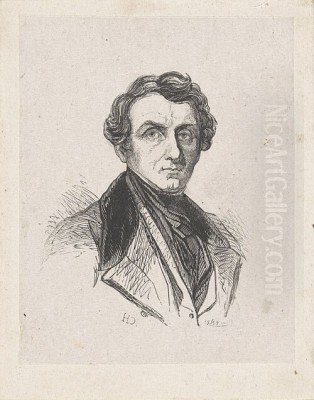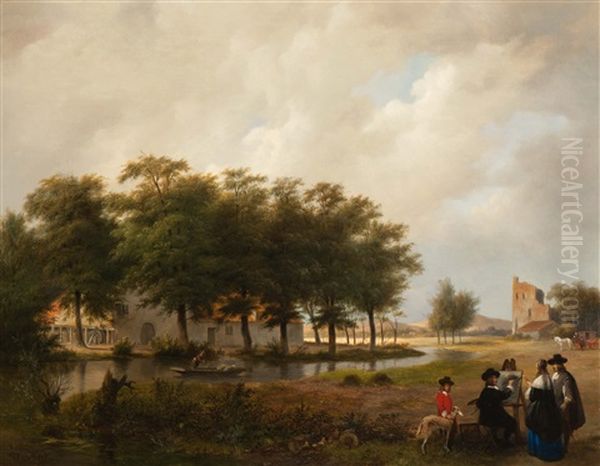
Bartholomeus Johannes van Hove stands as a significant figure in nineteenth-century Dutch art. Born in The Hague on October 28, 1790, and passing away in the same city on November 10, 1880, his long life spanned a period of considerable change in the artistic landscape of the Netherlands. He distinguished himself primarily as a painter of cityscapes and architectural views, particularly those of his native city, but his talents extended to landscape painting, watercolour, graphic arts, and notably, stage design. Furthermore, his role as an influential teacher cemented his legacy, shaping a generation of artists who would rise to prominence.
Early Life and Artistic Formation
Van Hove was born into an artistic environment. His father, Hubertus van Hove the Elder, was a painter, providing young Bartholomeus with his initial exposure to the craft. This familial connection to the arts likely fostered his early interest and provided foundational training. He learned the crucial skill of perspective drawing, an ability that would become a hallmark of his later architectural and urban scenes.
Seeking formal education, Van Hove enrolled in the Hague Academy of Fine Arts (Haagsche Teeken-Academie) around 1812. There, he further honed his skills, concentrating on architectural representation and the decorative arts. His training was also significantly shaped by Joannes Henricus Albertus Antonius Breckenheijmer, a painter of theatre decorations and his eventual father-in-law. This connection undoubtedly steered Van Hove towards his later successful career in stage design alongside his easel painting.
The Painter of Urban Life and Architecture
Van Hove's artistic reputation rests largely on his meticulously rendered depictions of Dutch towns and cities. He possessed a remarkable ability to capture the specific character of urban environments, combining topographical accuracy with a distinct atmospheric quality. His favoured subjects were often found in The Hague, including views of its bustling streets, tranquil canals, prominent buildings, and the interiors of its historic churches.

His style is characterized by careful attention to detail, precise draughtsmanship, and a sophisticated understanding of perspective and light. While rooted in the tradition of Dutch cityscape painting, tracing back to seventeenth-century masters like Jan van der Heyden, Van Hove imbued his scenes with a nineteenth-century sensibility. His work often displays elements of Romanticism, evident in the play of light and shadow, the inclusion of anecdotal figures (staffage) that animate the scenes, and an overall picturesque quality.
He didn't limit himself solely to The Hague. Views of Amsterdam and other Dutch locations also feature in his oeuvre. His church interiors, recalling the quiet solemnity found in the works of earlier artists like Pieter Jansz. Saenredam, demonstrate his versatility in handling complex architectural spaces and the subtle effects of light filtering through stained glass or illuminating stone pillars.
Representative Works
Among Van Hove's notable works, the painting often titled Scene of a Dutch City Canal with a Rescue Scene stands out. Signed and dated "B van Hove / I21," indicating completion in 1821, this relatively small panel (around 32 x 39 cm) executed on oak presents a dramatic urban vignette. It depicts a lively scene along a canal, reportedly showing an escapee plunging into the water while being pursued by authorities, observed by a crowd of onlookers. This work exemplifies his skill in combining detailed architectural settings with narrative human activity, creating a snapshot of city life.
Beyond this specific example, Van Hove produced numerous cityscapes that capture the essence of Dutch urbanism. Works depicting the Grote Markt (Great Market Square) in The Hague, various canal views featuring bridges and gabled houses, and detailed interiors of the Grote Kerk (Great Church) in The Hague are representative of his output. These paintings are valued for their historical documentation of the cities as they appeared in the nineteenth century, as well as for their artistic merit. His ability to render textures – brickwork, water, stone – and capture the specific light of the Netherlands contributed significantly to their appeal.
A Career in Theatre Design
Parallel to his career as an easel painter, Bartholomeus Johannes van Hove achieved considerable success as a stage designer. For many years, starting around 1829, he served as the principal decorator for the Royal Theatre (Koninklijke Schouwburg) in The Hague. This role required a deep understanding of perspective, architectural illusion, and dramatic effect, skills that clearly informed his painted cityscapes and interiors as well.
His stage designs were highly regarded and contributed significantly to the visual spectacle of theatrical productions in The Hague. This aspect of his career provided a steady income and kept him engaged with architectural representation on a grand scale. It's known that some of his students, including the talented Johannes Bosboom, assisted him in the theatre workshop, gaining practical experience in perspective and large-scale painting under his guidance. This dual career path highlights Van Hove's versatility and his practical application of artistic skills.
An Influential Teacher
Van Hove's impact extends significantly through his role as an educator. From 1820 onwards, he held teaching positions at the Hague Academy of Fine Arts, eventually becoming a professor. He was a dedicated instructor, and his studio became a training ground for many artists who would later achieve fame. His emphasis on solid drawing skills, perspective, and careful observation provided his students with a strong technical foundation.
His most prominent pupils include Johannes Bosboom, who became renowned for his atmospheric church interiors, and Jan Hendrik Weissenbruch, a key figure in the Hague School known for his luminous landscape paintings. Other notable students who benefited from his instruction were Charles Leickert, known for his winter cityscapes and beach scenes, Samuel Verveer, also a painter of cityscapes, Johannes Warnardus Bilders, a landscape painter associated with the early Hague School, and Alexander Hieronymus Bakker Korff, known for his detailed genre scenes. His own son, Hubertus van Hove, followed in his footsteps as a painter, specializing in interiors and genre scenes.
Through these students and others, Van Hove's influence permeated the Dutch art world. While his own style retained a more detailed, Romantic character, his teaching helped lay the groundwork for the development of the Hague School, which favoured a more realistic, atmospheric approach to landscape and genre painting later in the century. His students adapted his lessons to forge their own distinct artistic paths.
Contemporaries and Artistic Context
Bartholomeus Johannes van Hove worked during a period when Dutch art was finding its voice again after the disruptions of the late eighteenth and early nineteenth centuries. He was a contemporary of several other important Dutch artists. Andreas Schelfhout, a highly successful landscape painter known particularly for his winter scenes, was a prominent figure whose detailed style sometimes paralleled Van Hove's. Wijnand Nuyen, a gifted Romantic painter who died tragically young, was another contemporary whose work showed great promise.
Other notable artists of the era included Antonie Waldorp, who painted marines and cityscapes, and Barend Cornelis Koekkoek, arguably the most celebrated Dutch Romantic landscape painter of the period, known for his idealized forest and river scenes. Cornelis Springer emerged as another leading painter of cityscapes, often compared to Van Hove, though Springer developed a brighter, often sunnier palette later in his career. Van Hove's work, therefore, should be seen within this context of reviving national traditions while engaging with the broader European movement of Romanticism. His detailed cityscapes offered a distinct contribution alongside the popular landscapes and marine paintings of his peers.
Later Life, Recognition, and Legacy
Van Hove remained active as an artist and teacher for much of his long life. His dedication and skill earned him recognition and honours. King Willem II awarded him a silver medal for his work, acknowledging his contribution to the arts in the Netherlands. He was also appointed an officer in the Order of the Oak Crown, a chivalric order bestowed by the King of the Netherlands in his capacity as Grand Duke of Luxembourg, further signifying his respected status.
He continued to paint and exhibit, maintaining his reputation for detailed and evocative scenes. His death in The Hague in 1880 marked the end of a long and productive career that had significantly shaped the course of nineteenth-century Dutch painting, particularly in the genre of the cityscape and through his influential teaching.
Bartholomeus Johannes van Hove's legacy lies in his mastery of the architectural view and the cityscape, rendered with meticulous detail yet infused with a Romantic sensibility. He captured the appearance and atmosphere of Dutch cities during a specific period, leaving behind valuable visual documents. Equally important was his role as a teacher, nurturing a generation of artists, including key figures of the Hague School, who would build upon the foundations he helped establish.
Museum Collections
Today, the works of Bartholomeus Johannes van Hove are held in the collections of major museums in the Netherlands, ensuring their preservation and accessibility to the public. Significant holdings can be found at the Rijksmuseum in Amsterdam, the national museum of the Netherlands. The Kunstmuseum Den Haag (formerly Gemeentemuseum) in his hometown also possesses a number of his works, reflecting his strong connection to the city.
Other institutions where his paintings can be viewed include the Centraal Museum in Utrecht and the Museum Boijmans Van Beuningen in Rotterdam. These collections showcase the range of his work, from expansive city views and detailed church interiors to more intimate landscapes and watercolours, allowing contemporary audiences to appreciate the skill and artistry of this important nineteenth-century Dutch master. His presence in these national collections confirms his enduring place in the history of Dutch art.
Conclusion
Bartholomeus Johannes van Hove was a pivotal figure in nineteenth-century Dutch art. As a painter, he excelled in the genre of the cityscape and architectural interior, combining technical precision inherited from earlier Dutch traditions with the atmospheric concerns of Romanticism. His depictions of The Hague and other Dutch cities remain admired for their detail and evocative quality. His parallel career as a stage designer further showcased his command of perspective and architectural form. Perhaps most enduringly, his long tenure as a teacher at the Hague Academy profoundly influenced a generation of artists, bridging the gap between early nineteenth-century styles and the later realism of the Hague School. His work and his influence ensure his significance in the narrative of Dutch art history.